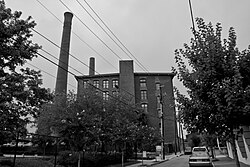Cabbagetown (Atlanta)
|
Cabbagetown District
|
|

A street in Cabbagetown
|
|
| Location | Atlanta, Georgia |
|---|---|
| Coordinates | 33°44′59″N 84°21′59″W / 33.74972°N 84.36639°WCoordinates: 33°44′59″N 84°21′59″W / 33.74972°N 84.36639°W |
| Built | 1881 |
| Architect | Unknown |
| Architectural style | Bungalow/Craftsman, Late Victorian, Romanesque |
| NRHP Reference # | 76000623 |
| Added to NRHP | January 01, 1976 |
Cabbagetown is a neighborhood on the east side of Atlanta, Georgia, United States, abutting historic Oakland Cemetery. It includes the Cabbagetown District, a historic district listed on the U.S. National Register of Historic Places.
The Atlanta Rolling Mill was destroyed after the Battle of Atlanta and on its site the Fulton Bag and Cotton Mill began operations in 1881. Cabbagetown was built as the surrounding mill town and was one of the first textile processing mills built in the south. Its primary product was cotton bags for packaging agricultural products. Built during a period when many industries were relocating to the post-Reconstruction South in search of cheap labor, it opened shortly following the International Cotton Exposition, which was held in Atlanta in an effort to attract investment to the region. The mill was owned and operated by Jacob Elsas, a German Jewish immigrant. Its work force consisted of poor whites recruited from the Appalachian region of north Georgia. Elsas built a small community of one and two-story shotgun houses and cottage-style houses surrounding the mill, originally known as Factory Town' or Fulton Mill Village. Like most mill towns, the streets are extremely narrow with short blocks and lots of intersections.
...
Wikipedia



